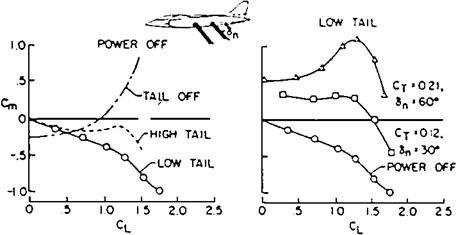Special VTOL Jet Inflow Effects
Deflected jet VTOL airplanes such as the Hawker-Siddeley Harrier and the McDonnell Douglas AV-8B Harrier II can have troublesome jet inflow effects on static
|
Figure 4.7 The low tail position that produces good stability at high lift coefficients for swept-wing airplanes can destabilize the airplane as a deflected jet VTOL. The left-hand diagram shows stability with jet power off; the right-hand diagram shows instability for a jet deflection angle of 60 degrees. (Reprinted with permission from SAE Paper No. 864A, © 1964, Society of Automotive Engineers, Inc.) |
longitudinal stability. Problems can arise at jet deflection angles that are intermediate between hovering and normal flight.
As shown in Figure 4.7, jet deflection angles of about 60 degrees can put the horizontal tail in an effective high position relative to the jet flow field. This causes large downwash angles over the tail (McKinney, Kuhn, and Reeder, 1964). This occurs in spite of an actual low tail position relative to the wing chord plane, which is necessary on swept wings to avoid transonic pitchup. In other words, finding a single horizontal tail vertical position to give good static longitudinal stability under all flight conditions may be difficult for swept-wing deflected-jet VTOL airplanes of the Harrier type.
An additional inflow problem occurs with tilt-rotor VTOL airplanes at high descent rates at low airspeeds. This problem is shared with rotary-wing aircraft. High descent rates can lead to asymmetric loss in lift and uncontrollable roll, because of upflow through propeller disks due to the descent rate. The upflow interferes with the downflow required for lift.












